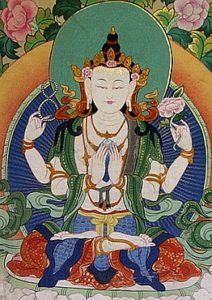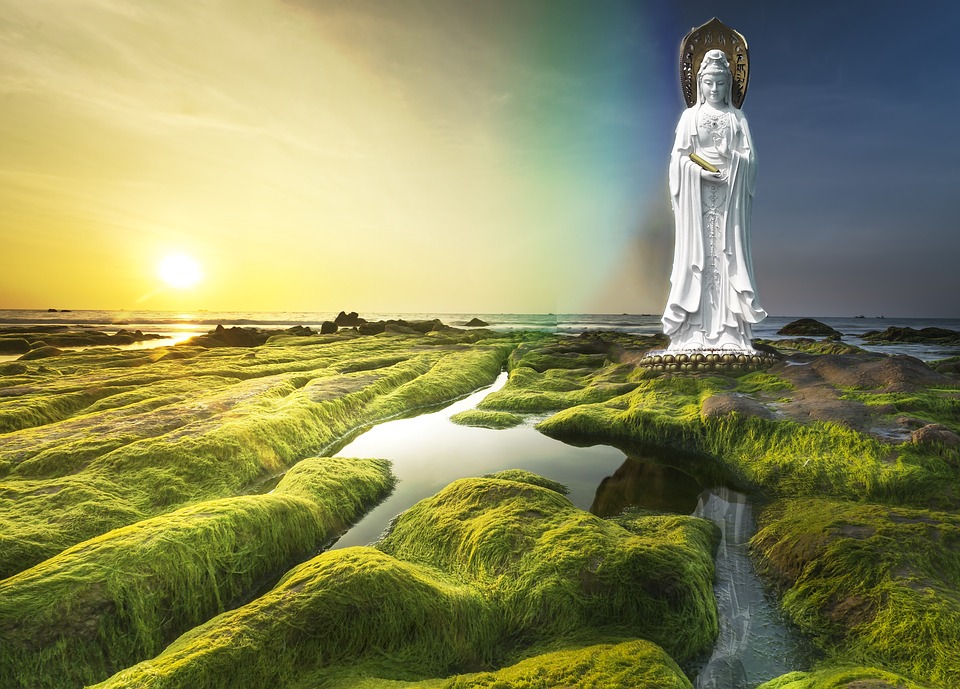John Daido Loori a Zen Master who founded Zen Mountain Monastery in New York said:
“Avalokiteshvara Bodhisattva is the Hearer of the Cries of the World. And one of the characteristics of Avalokiteshvara is that she manifests herself in accord with the circumstances. So she always presents herself in a form that’s appropriate to what’s going on. In the bowery, she manifests as a bum. Tonight, in barrooms across the country, she’ll manifest as a drunk. Or as a motorist on the highway, or as a fireman, or a physician. Always responding in accord with the circumstances, in a form appropriate to the circumstances.”
The god Avalokiteshvara – Bodhisattva of infinite compassion and mercy- is the personification of perfect compassion and determination. His vow is to save all sentient beings before entering the bliss of Buddhahood. When he realized that a great number of beings were still flooding into the hells, despite his teaching of the Dharma, his body shattered in great agitation and despair. This might seem extreme, but his exasperation was great.
Amitabha Buddha -who became his personal teacher- came to aid him with the spiritual force of Buddha’s powers and Avalokiteshvara obtained a new body with a thousand helping hands coupled with the eyes in each palm, which symbolized Wisdom and Compassion.
In this way he renewed the vow to save all sentient beings because “always responding in accord with the circumstances, in a form appropriate to the circumstances”.
The Origin
Avalokitesvara is the most popular of Mahayana Buddhist deities and is included in all Tibetan Buddhist traditions. He was born from a ray of light emanating from the eye of Amitabha, the Buddha of Infinite Light, the principal Buddha in the Land of Ultimate Bliss (Pure Land). Only through devotion to Amitabha Buddha the true human being gives up obsessions and fixations and achieves the central Mahayana concept of Nirvana.
 Avalokiteshvara motivated by pure compassion and love as a Godness of Infinite Compassion is a bodhisattva- the personification of bodhichitta- and he wishes to attain complete enlightenment for all beings. He is venerated as the ideal of Karuna, the activity of compassion in the world.
Avalokiteshvara motivated by pure compassion and love as a Godness of Infinite Compassion is a bodhisattva- the personification of bodhichitta- and he wishes to attain complete enlightenment for all beings. He is venerated as the ideal of Karuna, the activity of compassion in the world.
In China Avalokitevara -known as Kuan Yin- is depicted in a female form, an effect of Taoistic and Tantric influences from the 8th to 10th centuries. By the ninth century, her popularity had prevailed over that of Avalokiteshvara’s and she is often depicted as the Thousand Armed, Thousand Eyed bodhisattva. In particular, in the Fujian region of China, it appears as a maiden dressed in Tang dynasty style clothing holding a fish. She is represented in art together with Wei-tuo, one of the eight deities that protect the principles of Buddhism so in Buddhist temples you can find his statue behind the first Buddha statue, facing the main Temple.
The Bodhisattva’s Appearance
Many Buddhists utilize iconography of bodhisattvas in their practice. Especially are famous for the scroll paintings mounted on silk called tangkas. This kind of painting has distinctive features and unique artistic style.
During the 7th century, King Songtsan Gambo ordered the construction of Potala Palace and decorate them with paint murals. The King used the blood from his nose to paint a portrait of the goodness White Lhamo and it was hidden in the abdomen of the statue. This is the first kind of tangka painting.
There are more iconographic representations of Avalokiteshvara in Tibetan Buddhism and each of them can be distinguished by the body position, the number of heads and arms and by the gesture of bodhisattva’s hands. For example the gesture of turning the wheel of dharma, with the thumb and index finger of the right hand which symbolizes wisdom and method.





